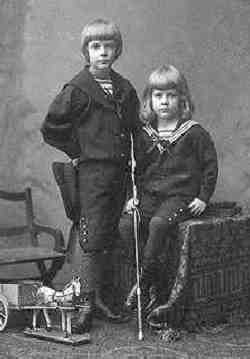
Figure 1.--These boys are dressed exactly alike, except for the older boy has Durch boy bangs while his younger brother still wears curls with his bangs. |

|
We have not yet found a good authoritative description of Dutch boy bangs. One problem here is that the term Dutch boy bangs is an English-language term used in America and Britain, but not a term used in the Netherlands and many other countries. The Dutch call Dutch boy bangs a Page boy cut. This is a further complication because Dutch boy bangs is not th only term used in america and Britain for essentially the dame cut. In English Dutch boy and Page boy cuts are often used interchangeably. And they are sometimes used to describe destinctive cuts. Dutch boys bangs usually refers to straight bangs with hair to about ear level. Page boy bangs commonly refer to hair cut longer at various lengths, but below the ears. And these destinction hve cganhd over time. For HBC we will be using these terms, but we would be interested in any insights that HBC readers may have.
Dutch-boy bangs presumably originated in Holland, although I have no historical details substantating that this was a popular hair style in Holland for boys or children in general. Perhaps one of our Dutch visitors can provide some background. The smiling Dutch boy corporate logo with his overalls and cap and woodenshoes is familiar to many Americans. Dutch boy images from the fairy tales--the one who plugged the dike with his finger, are familiar to children. The term Dutch boys bangs, however is
We have no details at this time on when Dutch boy bangs first appeared. We do not notice this hair style to any great extent until the 1890s. We do notice many images of boys with bangs, but not unil the 20th century do we begin to see a lot examples of the longer side hair which is the other element of Dutch boy bangs. In America as ringlet curls declined in popularity after the turn of the century, Dutch boy bangs became popular with many mothers. We see quite a number of boys with Dutch boy bangs in the erly 20th century. We think that Dutch boy bangs were especilly popular in the 1910s. A good example is an American boy, Floyd Van Horne, in the 1910s. We re not sure this chrnology also holds true for other countries, but we have gun to asses trends in other countries as well. Thisisdfficult because so images are not dated. When girls began bobbing their hair in the 1920s, it became a popular girls style and as a result, boys no longer liked it. There was a revival for boy's bangs which began with Jackie Kennedy's styling ofher son's hair in bangs. And then as long hair became popular in the 1970s we begin to see boys including teenagers with wht were essentially Dutch boys bangs, although the boys did not use that term.
We are collecting information on Dutch boy bangs in different countries. At this time much of our information comes from America. We are not sure this is because that Dutch boys bangs were especially popular in ameroca. We believe that this ws the case, but can not tell yet because our American archive is much more extensive than our oher country archives which my be the reaon we hve so many American examples.
Dutch boy bangs perhaps became popular in America after the turn of the century because it allowed some mothers to retain a longish hair style on their boys as the long hair and curls of the late 19th century were passing out of style. Dutch boy bangs made a comparitively easy transition from Fauntleroy curls. Many boys wearing ringlets had straight front bangs. Thus when mother deemed her son was old enough, his ringlets could be cut, but left over his ears for a few more years in the Dutch-boy style.
The bangs which appeared at the turn of the century are generally
associated with Buster Brown suits and, to a
lesser extent, Russian blouses. They were,
however, worn with many other styles such as sailor suits, but not as
commonly Fauntleroy suits.
It was always a major rite of passage for a boy to finally have his
curls cut and allowed to wear more closely cropped hair like his father.
Cutting a boys bangs
and allowing him to get a short hair cut with a center or side part was
a similar event.
Navigate the Boys' Historical Clothing Web Site:
[Return to the Main bangs page]
[Return to the Main hair style page]
[Introduction]
[Activities]
[Biographies]
[Chronology]
[Cloth and textiles]
[Clothing styles]
[Countries]
[Topics]
[Bibliographies]
[Contributions]
[FAQs]
[Glossaries]
[Images]
[Links]
[Registration]
[Tools]
[Boys' Clothing Home]
